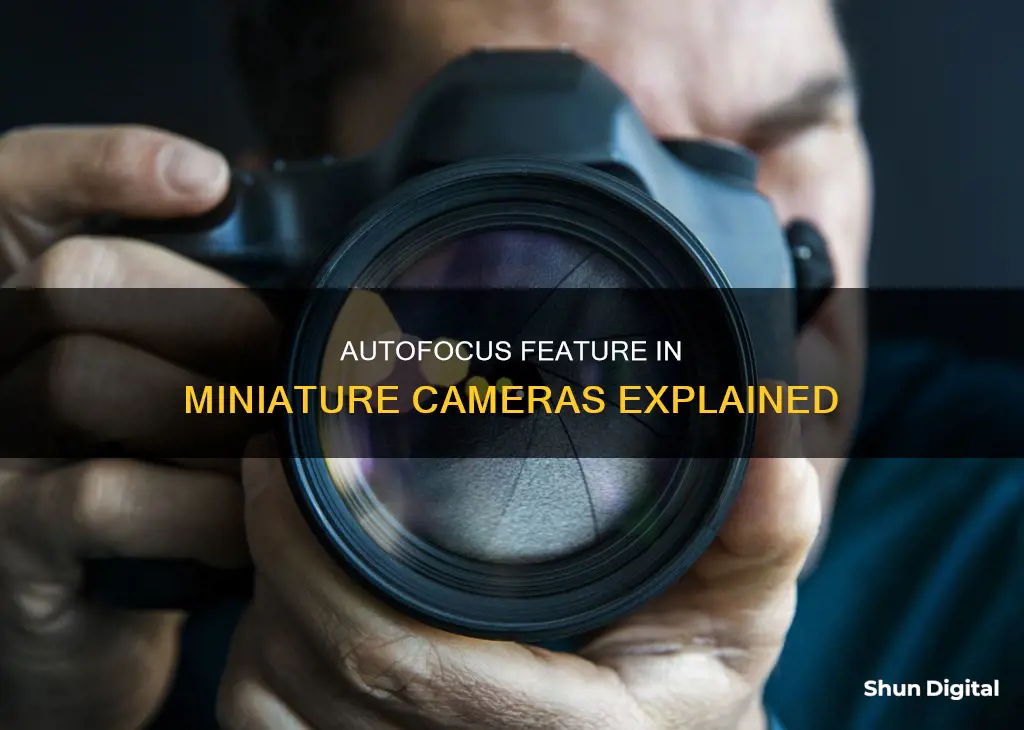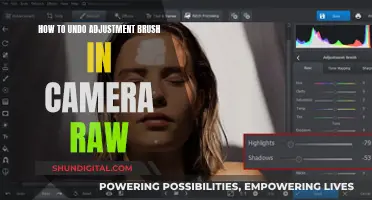
Autofocus is a feature in modern cameras that automatically adjusts the lens to obtain focus on the subject of a photograph. The autofocus system relies on sensors to determine the correct focus, with some systems using a single sensor and others employing an array of sensors. This process is generally faster and more precise than manual focus, although certain accessories can enhance the precision of manual focus. Autofocus can be categorised as active, passive, or hybrid systems. Active autofocus systems measure the distance to the subject independently of the optical system, using methods such as ultrasonic sound waves or infrared light. Passive autofocus systems, on the other hand, perform passive analysis of the image entering the optical system without directing energy towards the subject. Contrast-detection and phase detection are the two primary methods used in passive autofocus systems.
What You'll Learn

How autofocus works
Autofocus (AF) is a system that uses a combination of sensors, a control system and a motor to focus on a selected point or area. The autofocus sensor is the engine behind achieving accurate focus and is laid out in various arrays across the image's field of view. Each sensor measures relative focus by assessing changes in contrast at its respective point in the image.
There are two types of autofocus systems: active and passive. Active AF systems were used in the early days of autofocus technology and are rarely seen today. They work by emitting an ultrasonic or infrared signal toward the subject, which then reflects the sound or light back to the camera’s focus sensor. The camera then calculates how far away the subject is by measuring the time it took for the signal to return.
Passive AF is the choice of the vast majority of today’s cameras and can be performed using either the contrast detection or phase detection methods. In the case of the former, the camera commands the focus element of the lens to move while it reads any decrease in the intensity of light on a pixel or group of pixels. The maximum intensity indicates the region of sharpest focus. Phase detection, on the other hand, works by dividing the incoming light into pairs of images and comparing them. The camera then adjusts the focusing elements inside the lens until the two images appear identical.
Focusing Your Camera on FaceTime: Tips and Tricks
You may want to see also

Active vs passive autofocus
There are two types of autofocus (AF) systems: active and passive. Each system has its own advantages and disadvantages, and they are suited to different use cases.
Active AF
The active AF system works by emitting a red beam of light (usually infrared) towards the subject and then bouncing it back to the camera to calculate the distance between the camera and the subject. This system is great for use in low-light environments where passive AF often fails. However, it is only suitable for stationary subjects and subjects that are close to the camera.
Passive AF
The passive AF system works very differently. Instead of using a red beam to calculate the distance, it relies on "Phase Detection" or "Contrast Detection" to detect contrast. Passive AF is commonly found on single-lens reflex (SLR) autofocus cameras. It requires light and image contrast to function properly. It also has no distance limitations like the infrared beam of an active autofocus system and works fine through windows.
Hybrid AF
Some cameras combine active and passive autofocus systems to compensate for their individual weaknesses and increase overall reliability, accuracy, and speed.
Hikvision Cameras: Where Are They Manufactured?
You may want to see also

Types of autofocus sensors
Autofocus (AF) systems rely on one or more sensors to determine the correct focus. There are two main types of autofocus sensors: active and passive.
Active AF systems measure the distance to the subject independently of the optical system and then adjust the optical system for the correct focus. There are various ways to measure distance, including using ultrasonic sound waves or infrared light. In the case of ultrasonic sound waves, the camera emits sound waves and measures the delay in their reflection to calculate the distance to the subject. Infrared light, on the other hand, is typically used to triangulate the distance to the subject.
Passive AF systems, on the other hand, determine the correct focus by performing an analysis of the image entering the optical system. They do not direct any energy towards the subject. Passive autofocusing can be achieved through phase detection or contrast measurement.
Phase detection (PD) involves dividing the incoming light into pairs of images and comparing them. This method is often used in film and digital SLR cameras. The light is directed to an AF sensor using a beam splitter, creating a simple rangefinder. The two images are then analysed for similar light intensity patterns, and the system calculates the direction and amount of focus-ring movement required.
Contrast-detection autofocus, on the other hand, measures the contrast within a sensor field through the lens. The optical system is then adjusted until maximal contrast is detected. This method does not involve actual distance measurement and can be challenging when tracking moving subjects, as a loss of contrast does not indicate the direction of motion.
In addition to active and passive AF systems, there are also hybrid autofocus systems that combine two or more methods to improve reliability, accuracy, and speed. For example, a hybrid system may combine an active IR or ultrasonic autofocus system with a passive phase-detection system.
Pentax Cameras: Still in the Market?
You may want to see also

Factors affecting autofocus performance
The performance of autofocus (AF) in miniature cameras is influenced by several factors, including the photographic subject, lighting conditions, lens condition, and camera quality.
The subject of a photograph has a significant impact on autofocus performance. The three most crucial factors are light levels, subject contrast, and camera or subject motion. For instance, autofocus may struggle in low-light conditions or with subjects that lack contrast or have repetitive patterns. Additionally, moving subjects require different autofocus settings than stationary ones.
The quality and amount of light play a crucial role in autofocus performance. While autofocus typically functions well in daylight, it may encounter challenges in low-light conditions as cameras rely on light passing through the lens to detect contrast.
The condition of the lens can also affect autofocus. Physical issues such as dirt, dust, or mould on the lens can impact image quality and aperture performance, which in turn affects autofocus accuracy.
Lastly, the quality and robustness of the camera itself are factors. Different camera brands and models offer varying levels of autofocus performance, with Canon and Nikon often considered to have the most advanced AF systems that work well across various shooting conditions.
Understanding Auto Focus: How Does Your Camera Focus?
You may want to see also

Autofocus modes
Single Autofocus Mode (AF-S)
Single autofocus mode is the most basic autofocus option. When selected, the camera will lock the focus on the subject you want to photograph. This mode is best used for static subjects such as portraits, macro, and architecture. It is also the best mode for low-light conditions and astrophotography.
Continuous Autofocus Mode (AF-C)
Continuous autofocus mode is best used for moving subjects. Once you've set your focus, the camera will continue to track the subject, even if they move around within the frame. This mode is perfect for maintaining focus on moving subjects such as eyes for portraits, sports, and wildlife.
Hybrid Autofocus Mode (AF-A)
The Hybrid autofocus mode is best used when you aren't certain whether to use single or continuous autofocus mode. In this mode, the camera detects subject motion and switches between AF-S and AF-C accordingly. This mode is useful for challenging subjects with unpredictable movements, such as wildlife and small children.
Other Autofocus Modes
Other autofocus modes include the Manual Focus Mode (M) and the Automatic Autofocus Mode (AF-A). Manual focus mode is useful when autofocus makes mistakes or selects the wrong area/subject to track. Automatic autofocus mode, on the other hand, allows the camera to choose the focus points and is best for novice photographers.
Samsung S8 Camera Mode Button: What's It For?
You may want to see also
Frequently asked questions
Autofocus (AF) is a system that uses a sensor, a control system, and a motor to automatically focus on a selected point or area.
Autofocus systems use one or more sensors to determine the correct focus. The data collected from these sensors is then used to adjust the focus of the optical system.
There are three main types of autofocus: active, passive, and hybrid. Active AF systems measure the distance to the subject independently, while passive AF systems analyse the image entering the optical system. Hybrid AF combines both active and passive methods.
Miniature cameras typically use passive autofocus systems, such as phase detection or contrast detection. These systems analyse the image entering the lens and adjust the focus accordingly.
Autofocus in miniature cameras can help to ensure that the subject is in focus, even when the camera is moving or in low-light conditions. It can also speed up the photography process and reduce the need for manual adjustments.







